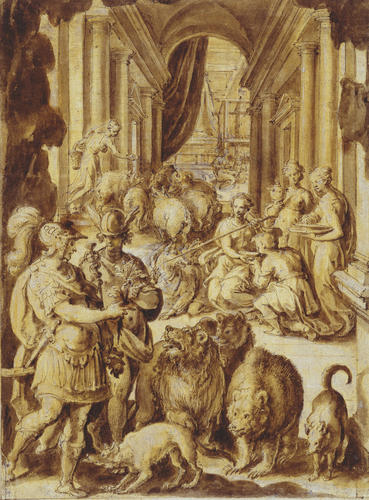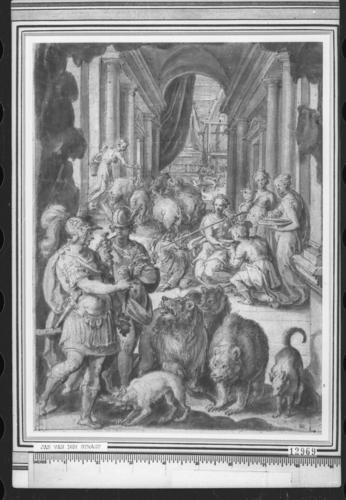Ulysses and Circe 1570
Pen and brownish-black ink with brownish-grey wash, heightened with white, over traces of black chalk, on yellow prepared paper | 29.9 x 22.0 cm (sheet of paper) | RCIN 912969
-
A drawing of groups of figures and animals within a receding arcade; in the left foreground Ulysses is led in by Mercury, who gives him the 'moly' root to protect him from Circe; they are watched by several of Ulysses' companions who have changed into animals. Behind, the seated Circe, holding her magic wand, and watched by two female companions, administers the magic potion to one of Ulysses' followers. Further back animals are fed by a female servant (from Book X, Ovid's Metamorphoses).
Jan van der Straet travelled as a young man from Flanders to Italy (where he adopted the name Giovanni Stradanus), and spent most of his career in Florence. This is a study for a painting in Francesco de’ Medici’s cabinet room or studiolo in the Palazzo Vecchio. After the Trojan War, Odysseus landed on the island of the sorceress Circe, who turned his companions into animals. Odysseus set out to Circe’s palace to free the men, protected by a herb given to him by Mercury, here at lower left.
This is a study for a painting of Odysseus and Circe in the Studiolo of Francesco de’ Medici (later Grand Duke of Tuscany), leading off the main chamber (the Sala del Cinquecento) of the Palazzo Vecchio, Florence. Francesco was fascinated by the sciences and natural phenomena, especially the metamorphic sciences such as alchemy, metallurgy and pharmacy, and the Studiolo was designed as a cabinet room to house his collection of small and precious objects, both natural and man-made. The room is lined with paintings following an iconographic programme devised during 1570 by Vasari and the learned Vincenzo Borghini, on the theme of (in the ceiling) the four elements, seasons and humours, and (around the walls) their interactions and transformations.
The paintings fronting the cabinets are in two tiers, rectangular above and oval below, and in general the many painters who contributed to this scheme were each assigned a pair of vertically adjacent panels. Stradanus’s pair, to the right of centre of the left (Fire) wall, depict an Alchemist’s laboratory above and Odysseus and Circe below, each signed and dated IOANES STRATENSIS FLANDRUS 1570. Elaborate studies for the two paintings are in the Royal Collection; both are rectangular, suggesting that Stradanus devised the compositions at a stage in the planning when it was intended to have two equal tiers of rectangular paintings. The subsequent decision to use an oval format for the lower paintings required Stradanus to modify this composition, compressing it widthways and rearranging the animals.
The subject is taken from Book 10 of the Odyssey. During their journey home after the Trojan War, Odysseus and his companions landed on the island of the sorceress Circe. At centre right she is shown feeding one of the men with soup drugged with a potion that turned them into pigs: to the left of Circe is a man mid-transformation, on all fours with a pig’s head, while behind a servant feeds the swine. Odysseus set out to Circe’s palace to release the men, protected by a ‘moly root’ given by Mercury (with the winged helmet, in the left foreground beyond Odysseus). The Odyssey mentions only pigs, though the popularity of Giovanni Battista Gelli’s La Circe (1549), ten dialogues between Circe, Odysseus, and his transformed companions, ranging from an oyster to an elephant, encouraged the depiction of a variety of animals - here a lion, a bear, a wolf and a fox. In the distance is Penelope, the wife of Odysseus, seated at her loom as she passes the years waiting for his return.
Catalogue entry adapted from The Art of Italy in the Royal Collection: Renaissance and Baroque, London, 2007Provenance
Probably in the Royal Collection by c.1810
-
Medium and techniques
Pen and brownish-black ink with brownish-grey wash, heightened with white, over traces of black chalk, on yellow prepared paper
Measurements
29.9 x 22.0 cm (sheet of paper)
Other number(s)
RL 12969Alternative title(s)
Odysseus and Circe










